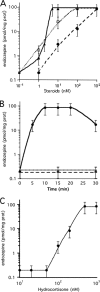Pregnenolone sulfate and cortisol induce secretion of acyl-CoA-binding protein and its conversion into endozepines from astrocytes
- PMID: 20452969
- PMCID: PMC2898429
- DOI: 10.1074/jbc.M110.105858
Pregnenolone sulfate and cortisol induce secretion of acyl-CoA-binding protein and its conversion into endozepines from astrocytes
Abstract
Acyl-CoA-binding protein (ACBP) functions both intracellularly as part of fatty acid metabolism and extracellularly as diazepam binding inhibitor, the precursor of endozepine peptides. Two of these peptides, ODN and TTN, bind to the GABA(A) receptor and modulate its sensitivity to gamma-aminobutyric acid (GABA). We have found that depolarization of mouse primary astrocytes induces the rapid release and processing of ACBP to the active peptides. We previously showed that ODN can trigger the rapid sporulation of the social amoeba Dictyostelium. Using this bioassay, we now show that astrocytes release the endozepine peptides within 10 min of exposure to the steroids cortisol, pregnenolone, pregnenolone sulfate, or progesterone. ACBP lacks a signal sequence for secretion through the endoplasmic reticulum/Golgi pathway and its secretion is not affected by addition of brefeldin A, a well known inhibitor of the classical secretion pathway, suggesting that it follows an unconventional pathway for secretion. Moreover, induction of autophagy by addition of rapamycin also resulted in rapid release of ACBP indicating that this protein uses components of the autophagy pathway for secretion. Following secretion, ACBP is proteolytically cleaved to the active neuropeptides by protease activity on the surface of astrocytes. Neurosteroids, such as pregnenolone sulfate, were previously shown to modulate the excitatory/inhibitory balance in brain through increased release of glutamate and decreased release of GABA. These effects of steroids in neurons will be reinforced by the release of endozepines from astrocytes shown here, and suggest an orchestrated astrocyte-neuron cross-talk that can affect a broad spectrum of behavioral functions.
Figures





Similar articles
-
A novel role for central ACBP/DBI as a regulator of long-chain fatty acid metabolism in astrocytes.J Neurochem. 2015 Apr;133(2):253-65. doi: 10.1111/jnc.13035. Epub 2015 Feb 6. J Neurochem. 2015. PMID: 25598214
-
The gliotransmitter ACBP controls feeding and energy homeostasis via the melanocortin system.J Clin Invest. 2019 Apr 2;129(6):2417-2430. doi: 10.1172/JCI123454. J Clin Invest. 2019. PMID: 30938715 Free PMC article.
-
Endozepines and their receptors: Structure, functions and pathophysiological significance.Pharmacol Ther. 2020 Apr;208:107386. doi: 10.1016/j.pharmthera.2019.06.008. Epub 2019 Jul 5. Pharmacol Ther. 2020. PMID: 31283949 Review.
-
DBI/ACBP loss-of-function does not affect anxiety-like behaviour but reduces anxiolytic responses to diazepam in mice.Behav Brain Res. 2016 Oct 15;313:201-207. doi: 10.1016/j.bbr.2016.06.052. Epub 2016 Jun 27. Behav Brain Res. 2016. PMID: 27363924
-
Glial endozepines and energy balance: Old peptides with new tricks.Glia. 2021 May;69(5):1079-1093. doi: 10.1002/glia.23927. Epub 2020 Oct 26. Glia. 2021. PMID: 33105065 Review.
Cited by
-
Cell signaling during development of Dictyostelium.Dev Biol. 2014 Jul 1;391(1):1-16. doi: 10.1016/j.ydbio.2014.04.001. Epub 2014 Apr 12. Dev Biol. 2014. PMID: 24726820 Free PMC article. Review.
-
Astrocyte Gliotransmission in the Regulation of Systemic Metabolism.Metabolites. 2021 Oct 26;11(11):732. doi: 10.3390/metabo11110732. Metabolites. 2021. PMID: 34822390 Free PMC article. Review.
-
The Gliopeptide ODN, a Ligand for the Benzodiazepine Site of GABAA Receptors, Boosts Functional Recovery after Stroke.J Neurosci. 2021 Aug 18;41(33):7148-7159. doi: 10.1523/JNEUROSCI.2255-20.2021. Epub 2021 Jul 1. J Neurosci. 2021. PMID: 34210784 Free PMC article.
-
Facets of Autophagy Based Unconventional Protein Secretion-The Road Less Traveled.Front Mol Biosci. 2020 Dec 9;7:586483. doi: 10.3389/fmolb.2020.586483. eCollection 2020. Front Mol Biosci. 2020. PMID: 33363205 Free PMC article. Review.
-
Atlas of expression of acyl CoA binding protein/diazepam binding inhibitor (ACBP/DBI) in human and mouse.Cell Death Dis. 2025 Feb 26;16(1):134. doi: 10.1038/s41419-025-07447-w. Cell Death Dis. 2025. PMID: 40011442 Free PMC article.
References
-
- Faergeman N. J., Wadum M., Feddersen S., Burton M., Kragelund B. B., Knudsen J. (2007) Mol. Cell. Biochem. 299, 55–65 - PubMed
-
- Knudsen J., Mandrup S., Rasmussen J. T., Andreasen P. H., Poulsen F., Kristiansen K. (1993) Mol. Cell. Biochem. 123, 129–138 - PubMed
-
- Guarneri P., Berkovich A., Guidotti A., Costa E. (1990) Neuropharmacology 29, 419–428 - PubMed
-
- Slobodyansky E., Guidotti A., Wambebe C., Berkovich A., Costa E. (1989) J. Neurochem. 53, 1276–1284 - PubMed
Publication types
MeSH terms
Substances
Grants and funding
LinkOut - more resources
Full Text Sources
Other Literature Sources

